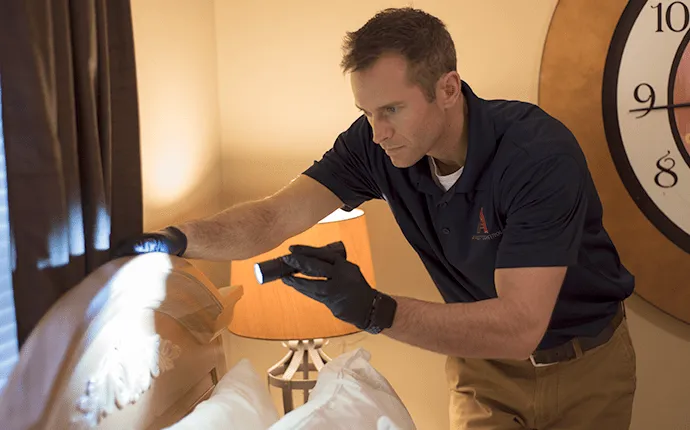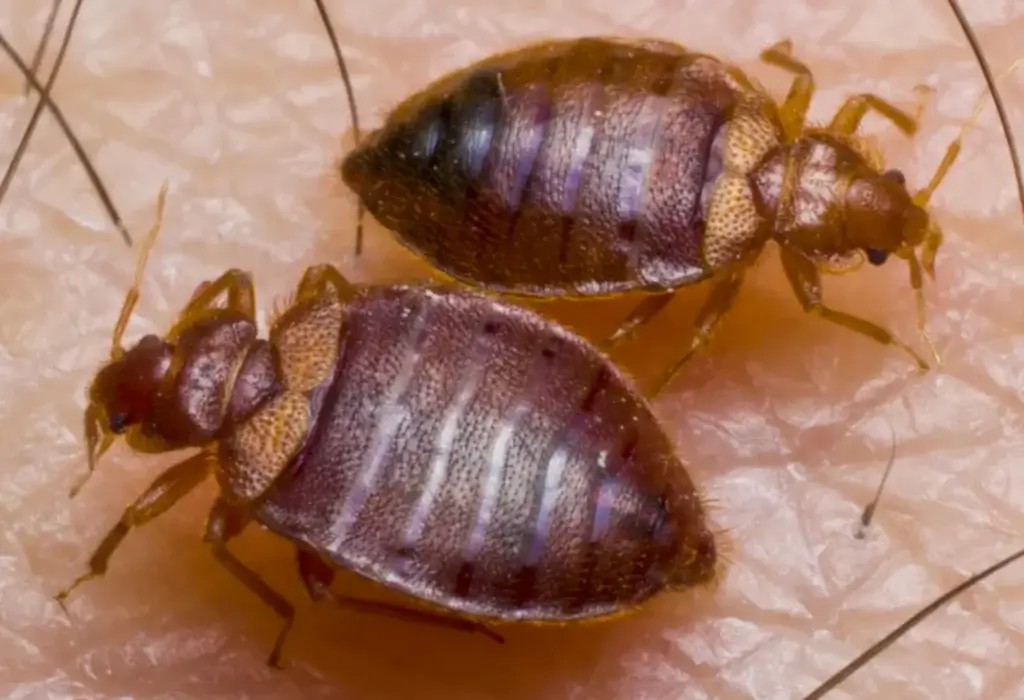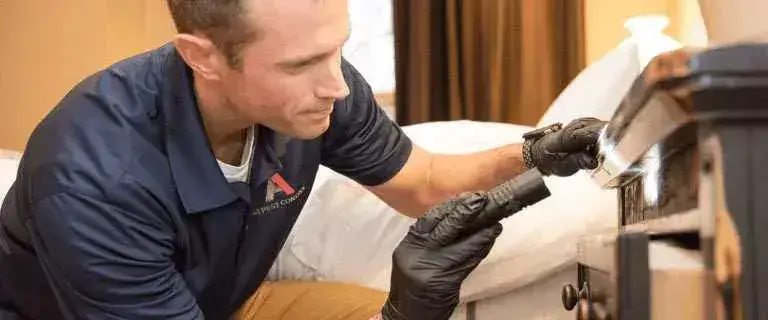
What Does A Professional Bed Bug Treatment Look Like?
When bed bugs infest your home, getting rid of them can be a miserable and lengthy process. Whether you're a homeowner or a business owner, bed bugs can be a nightmare to deal with because they are extremely hard to get rid of. So how does professional bed bug treatment help and what does it entail?


Table of Contents
Why Are Bed Bugs So Problematic?
Bed bugs are highly problematic due to their elusive nature, resilience, and the discomfort they cause. They're skilled at hiding in cracks, crevices, and even within mattresses, making them challenging to detect and eliminate. Bed bugs can go without feeding for months, allowing them to survive in empty homes and reemerge when conditions are favorable. That's why it's so important to identify bed bugs early.
Bed bug infestations often spread rapidly, as bed bugs can hitch a ride on clothing, luggage, or furniture, making them a common problem in hotels and other public spaces. Effective bed bug eradication typically requires professional bed bug treatment, making them a time-consuming pest to eliminate, which is why they are considered a significant nuisance and concern for homeowners and businesses alike.
The Impact Bed Bugs Have On A Business
Bed bugs are bad for business - especially if you own a hotel or restaurant. It creates liabilities and gives the impression that the establishment is filthy and doesn't conduct business well.
When a single bed bug is found by a customer, it can lead to hysteria. Nowadays, customers don't typically report bed bugs to the owner. Instead, people take to review sites and social media to vent their disgust over what they perceive as negligence--even though this is completely unwarranted.
Most people have no idea how a bed bug infestation spreads, and that finding a single bed bug does not mean there is a widespread infestation. Businesses need to be aware of these challenges and have a professional bed bug treatment and pest control plan to protect their brand.
The Impact Bed Bugs Have On A Family
Bed bugs can plague an entire family with bites, but this is actually not the worst threat they pose. There is a growing body of evidence that suggests that bed bugs spread illness to humans. One illness that is quite worrisome is Chagas disease, which is caused by the parasite Trypanosoma cruzi.
Symptoms of Chagas disease include fever, rash, swelling, headache, loss of appetite, swollen glands, nausea, diarrhea, vomiting, and enlargement of the liver or spleen. This has entomologists concerned because bed bugs live almost exclusively with humans, which gives these insects more opportunity to spread this illness than the kissing bug, which is the insect originally known for spreading it.
How a Bed Bug Infestation Starts
Bed bug infestations typically start when a few individual bed bugs or their eggs are introduced into a new environment. Once introduced, bed bugs reproduce rapidly, with females laying hundreds of eggs. These eggs hatch into nymphs, which mature into adult bed bugs in a matter of weeks, allowing the infestation to grow and spread if not promptly addressed.
Bed bugs can enter a home or business in many different ways:
- Travel: Bed bugs are skilled hitchhikers and can be unknowingly transported in luggage, clothing, or belongings when people stay in infested hotels, hostels, or even visit friends and family.
- Secondhand Furniture: Used furniture, particularly mattresses, sofas, and chairs, can harbor bed bugs if not properly inspected before bringing them into a home.
- Clothing and Personal Items: Bed bugs can infest clothing, bedding, and personal items in places like laundromats, communal spaces, or public transportation.
- Visitors: Guests who unknowingly carry bed bugs in their belongings can introduce these pests to a home when they visit.
- Neighboring Infestations: In apartment buildings or closely connected dwellings, bed bugs can move between units through wall voids, electrical conduits, or plumbing pipes, leading to infestations in neighboring spaces.

Prevention with Professional Bed Bug Treatment
The complexity of getting rid of bed bugs and their impact on businesses and families make professional bed bug treatment vital. Experienced pest control technicians follow strict protocols for bed bug inspection and treatment to ensure the complete elimination of these bugs.
Professional bed bug treatment is a multi-step process designed to effectively eliminate bed bug infestations from homes, businesses, and other environments. Here's an overview of the typical steps involved in getting rid of bed bugs:
- Inspection and Assessment: The first crucial step is a thorough inspection by a trained pest control professional. They identify the extent of the infestation, locate hiding spots, and assess the severity of the problem. This assessment helps determine the appropriate professional bed bug treatment strategy.
- Preparation: Before treatment begins, the affected area must be prepared. This involves decluttering, removing items from drawers and closets, and washing or heat-treating infested bedding, linens, and clothing. Vacuuming may also be necessary to reduce the bed bug population.
- Chemical Treatment: Pest control professionals may use a variety of insecticides or pesticides that are approved for bed bug treatment. These treatments are typically applied to cracks, crevices, and areas where bed bugs are known to hide. The choice of pesticide and application method depends on the specific circumstances and the professional's expertise.
- Follow-Up Inspections: After the initial treatment, pest control professionals conduct follow-up inspections to ensure that the infestation has been successfully eliminated. Additional treatments may be necessary if any bed bugs or eggs are found during these inspections.
- Preventative Measures: To prevent reinfestation, professionals may recommend certain preventative measures, such as encasing mattresses and box springs with bed bug-proof covers, using bed bug interceptors, and implementing good hygiene practices.
Professional bed bug treatment is essential for severe infestations and can be highly effective when carried out by trained experts. DIY methods are often inadequate for eradicating bed bugs completely. It's crucial to work with a licensed and experienced pest control company to ensure the successful elimination of these stubborn pests and to minimize the risk of re-infestation.
Why DIY Bed Bug Treatments Don't Work
One of the most common ways we've seen bed bug infestations begin is with homeowners spotting bed bugs, and attempting a DIY approach. While there are a lot of ways to kill a bed bug, simply smashing these bugs rarely solves the issue.
In fact, if you see bed bugs and don't call an exterminator, it can prolong or even cause a full-blown bed bug infestation. Why?
Bed bugs are notoriously sneaky. Sure, they'll hide in your sheets and mattresses, but they may also hide in bags, clothing, shoes, furniture, curtains, or even inside your walls! So after smashing those squatters, you may think you got rid of your infestation - but they may just be hiding inside your wall voids.
This can quickly become a cycle. It could have you throwing out mattresses, box springs, couches, and chairs, or even tearing apart your walls. The better alternative is to seek the assistance of an exterminator for a professional bed bug treatment.
What To Expect From A-1 Pest Control
At A-1 Pest Control, we use chemical bed bug control methods. During the initial meeting, your technician will perform an inspection to determine a plan that will work best for your unique situation.
Chemical treatments are used to get rid of bedbugs and keep them from coming back. This treatment method requires multiple visits but is more cost-effective. When applied by an educated professional, chemicals present no threat to the occupants returning to the home after the treatment, and they leave a barrier of protection against future infestations.
If you live in North Carolina and you'd like more information about the process of bed bug extermination or you'd like to schedule service, give us a call today. A-1 Pest Control is an industry leader in commercial and residential bed bug control.
